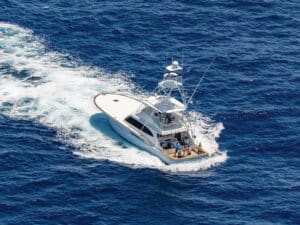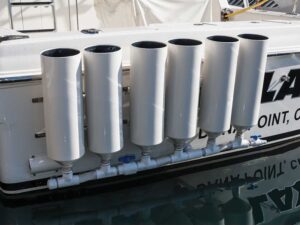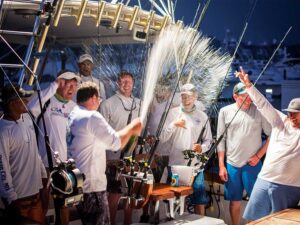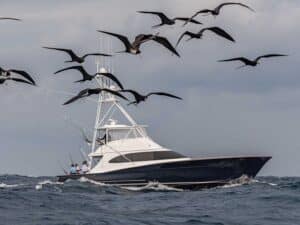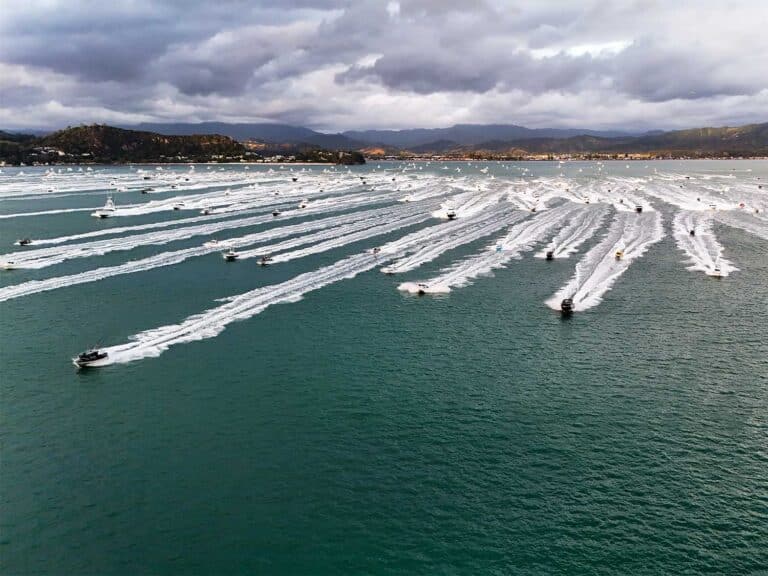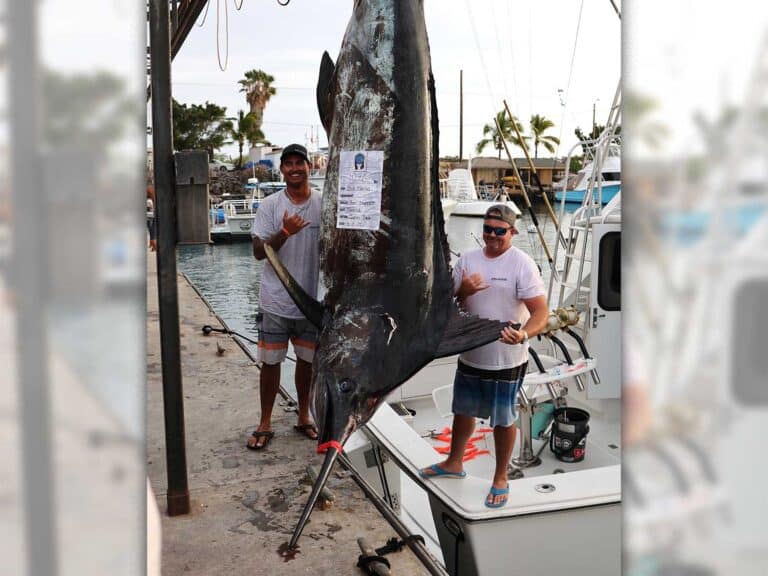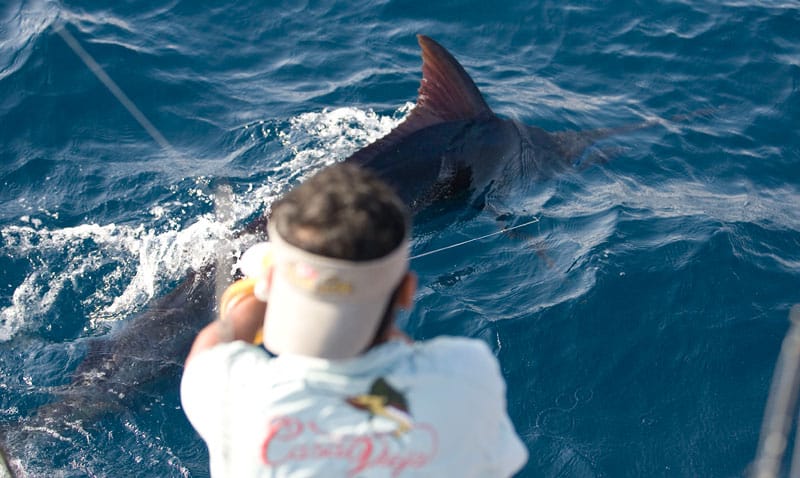
A lot has been written about angling for marlin, wiring marlin and the use of special boat-handling tactics when fighting one. A good analogy for this game, since every aspect of it is dependent on the behavior of the marlin itself, is that of a complex dance. But in this performance, the one who takes the lead can change in an instant.
Of course, the crew wishes to do as much of the leading as possible, constantly trying to pressure the fish into behaving in a way that allows a relatively frail human being to subdue a much bigger and stronger animal. So, now, the dance also becomes a sort of chess match, with one player’s move dictating the next move of the opposing player.
The crew’s biggest advantage is intelligence. Through experience, the captain and crew familiarize themselves with most, or all, of the numerous possible moves the fish could make. This allows them to try and encourage the fish to move in certain ways that increase their chances of a successful capture and release.
For a top-notch professional crew, especially those lucky enough to have either charter clients or private bosses who like to chase world-record-size billfish, the end of the chess match/dance is the most thrilling and fun part of the fight; it’s the part that ultimately determines the winner.
Here, then, are some of the finer points of close-quarters boat handling and pulling on the leader.
Physiology and Strategy
Any animal (including a fish) that makes a long, hard sprint at full speed goes into oxygen debt. After expending all of its oxygen supply during the sprint, the animal must slow down to try to regain the necessary levels of oxygen in the blood. It then attempts to take in oxygen faster than its muscles are burning it at the slower speed.
A skillful boat handler, angler or wire man can often coax a fish that has slowed down because of lack of oxygen into a behavior that would be categorized as panic. If the crew can induce this panic at the right time, the fish burns up even more energy instead of regaining it, further depleting its oxygen supply. And if the angler can exert a lot of drag right after the fish stops its initial run and tries to recover, the fish will continue to consume vast quantities of oxygen while fighting the heavy drag, which will slow it down even more.
All of the big pelagic marine predators need to swim forward in order to breathe. If you force a fish to move slowly by applying heavy drag pressure, it won’t get as much oxygen as it needs, and will usually give up the fight rather quickly.
To start the end game, the captain and the angler must get the fish close to the boat, or the boat close to the fish, so the wire man can grab the leader. In some extreme instances, however, and especially when you get on top of a green fish quickly, the captain must actually move away from a wildly leaping fish to keep it from jumping into the boat and hurting someone. In this case, the boat should not try to run away from the jumping fish, but should try to move over to one side and let the fish pass. After avoiding the possible collision, the skipper should then speed up and run alongside the fish, remaining alert for the possible need to turn away from the fish should it change its course back toward the boat.
In this situation, the captain is doing exactly what he should do when a hooked fish runs away from the boat. In both situations, once the fish slows or settles down, the captain should position the boat up-sea from the fish. He can then start backing down toward the fish, which will still be tired and low on oxygen from its initial hard run.
This is a much different tactic than what you normally see on most nonprofessional game boats. On most boats, when the team hooks a marlin weighing no more than three to five times the breaking strain of the line, the captain chases the fish in reverse while the angler applies only a modest amount of drag. This is a terrible way to fight a fish, especially if there is even a modest chop running. (You should only back a boat up going down-sea.)
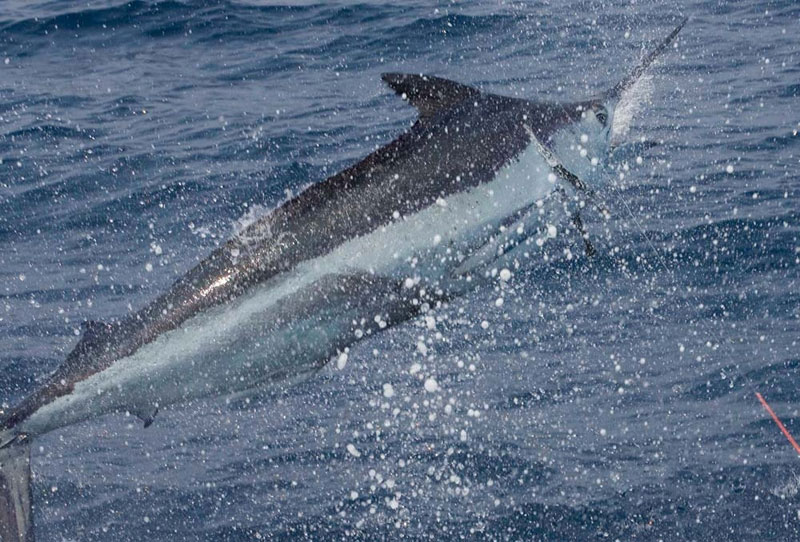
Taking the Leader
As the fish slows down from its initial burst, the boat eventually overtakes it, all the while regaining the line lost in the strong run. When the deckhand grabs the leader, the fish will still be swimming away from the boat, on or near the surface.
A less-skilled mate, trying to show how strong he is, may immediately start pulling on the fish as soon as he grabs the leader. This often causes the fish to try to speed up and get away from the boat. A fish that’s hooked in the mouth will pull hard against the wire, causing its head to rise up out of the water. Usually, this makes the fish try to jump. Since the mate has a fistful of double wraps when the fish starts to leave the water, the strain on the leader causes the fish to go mostly straight up. A small billfish may even somersault over and land on its back — with its bill facing the transom. This is a dangerous situation, since even a small billfish can cause serious injury if, on its next jump, it comes flying into the cockpit.
A larger fish may just break the leader, which results in a lost, not released, fish. Or, if the leader doesn’t break and the mate doesn’t let go, the fish may just yank the mate overboard. Mates have lost their lives this way.
The only correct tactic that a mate should employ when he’s got a fish on the leader that’s jumping away from the boat is to simply let go. This allows the fish to continue jumping away from the boat and lets the captain keep backing up for another shot at the leader. The skill of taking wraps, and knowing when to dump them quickly, is absolutely essential for any mate handling big, strong fish.
A good wire man, one who is trying to control the fish and make it behave in a way that allows it to be tagged or gaffed, takes hold of the leader almost gently at first, even though the leader may be many times stronger than the line class. If the fish surges away, the mate lets go, knowing that the captain will continue reversing and get the leader back into range. The fight is not lost as long as the fish is still on the hook!
If the fish continues to pull steadily, the first thing the mate should do is move away from the center of the transom and into one of the aft corners of the cockpit — usually the one closest to the fish. The mate should never stay in the center of the boat, no matter how well he can brace himself against the stern covering board. If the fish changes course, or the boat needs to change direction, the mate may need to rapidly move from one corner to the other, many times, without ever releasing the leader.
With either a tired or a calm fish, where the mate can hang on, pulling hard but with the fish not jumping, the mate must still go to one corner.
The captain can now back up fast, but slightly to one side of the fish. The captain’s move at this time may depend on which corner the mate has chosen, or the captain may have to tell the mate to switch sides. (See next page, “Switching Sides.”)
From his vantage point on the bridge or tower, the skipper now tries to get the wire man in the right corner and maneuver the boat in such a way as to help the mate hold on to the leader without letting go.
When a fish gets close to the boat, it generally tries even harder to move away from all the noise and commotion than when it was merely pulling against the drag. This sometimes evolves into a common situation, where the fish is too tired to get its head turned away from the boat but still has enough strength left to continue to try to stay down.
If there is a significant amount of line off the reel, and the crew is not prepared to use enough drag, they wind up dragging the fish forward through the water, while it uses only a small amount of energy to stay several feet, or yards, below the surface. The unknowing angler and crew are treating this fish exactly the way the top crews use small tunas for live bait. They keep the baits artificially resuscitated by dragging them through the water, not too fast and not too slow, but at just the right speed, around 3 knots.
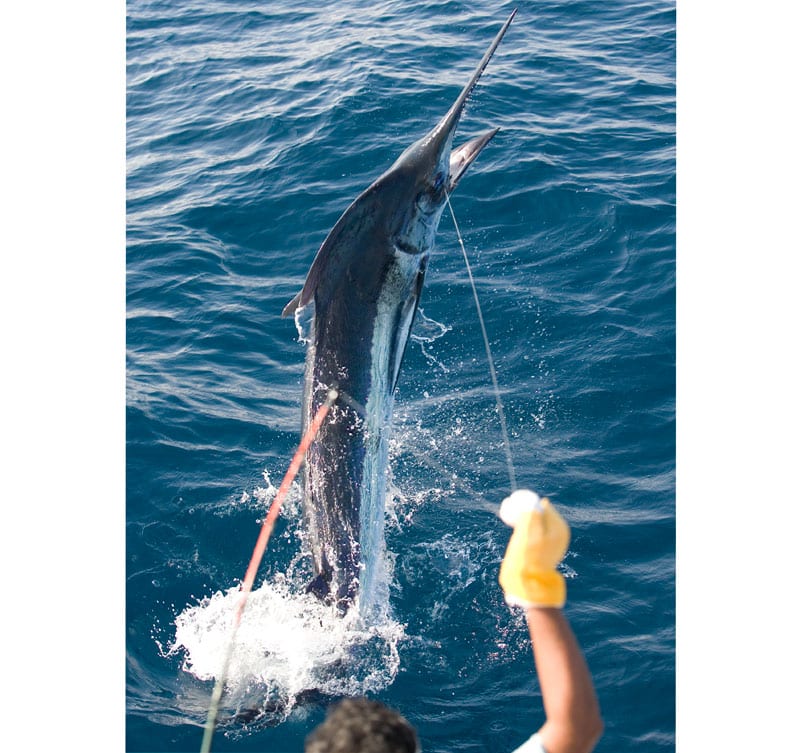
A less than experienced captain will slow down when the angle of the line rises to 30 or 45 or even 60 degrees above horizontal and the angler pumps the fish toward the boat, both gaining line but allowing the fish to revive itself with the forward motion.
If the captain now backs down toward the fish, the strain on the fish decreases, allowing the fish to dive even deeper below the surface. When the boat backs up too close to the line, the skipper puts the engines back into forward. The nearly exhausted angler is told to “Take a break and have some water, and let the harness take the strain,” while the skipper once again moves the boat ahead. After the second or third time, the fish may gain enough strength from this ill-advised maneuver to be able to turn away from the boat and take out line against the drag.
As the fish tires again, and moves too slowly to acquire enough oxygen, it allows itself to be turned around and dragged forward, which resuscitates it yet again — and the cycle repeats. This guarantees a long, hard fight for the angler!
A somewhat similar scenario unfolds when a good angler, using heavy drag for the line class, fights a big fish that is “pinwheeling.”
This occurs when a tuna or marlin gets into a circle and refuses to come up higher in the water column, and can manage to maintain a high and steady pressure against the angler. In one part of the circle, the captain may have to move the boat away from the fish to keep the line from fouling on a rudder or prop.
Many skippers alternate between going forward and reversing backward to cope with the changes in the angle of the line caused by a circling fish. The problem with this is that the crew is spending half the time resuscitating the fish. It is much better to slow it down and pull against the fish at all times in order to constantly deprive it of oxygen.
A captain that goes ahead too fast, even in a turn, is both helping the fish get oxygen and crushing his mate. The fish becomes a giant planer, and the faster the boat goes, the more pressure you put on the poor wire man. A much better tactic is to position the boat inside the fish’s circle, and spin the boat with one engine in forward and one in reverse with the rudder turned to complement the turning moment of the engine in forward gear.
To slow the fish as much as possible and deprive it of oxygen, you can allow the fish to swim ahead of the centerline of the transom. The drag from the mouth is slightly back toward the tail. From the boat, it appears that the fish is swimming sideways to the boat’s transom.
Eventually, the tiring and suffocating fish turns toward the boat to relieve the pressure. Do not run the boat forward when this happens — you could cut the line. Instead, quickly change the direction of the boat’s rotation by switching which engine is ahead and which is reverse. You must also turn the steering wheel to hard lock in the opposite direction.
In the first part of this maneuver, the deckhand will get a couple of pulls of wire as the fish gets closer to the boat. Frequently, the skipper will have to accelerate the engine in forward while spinning rapidly. The fish passes just under the corner of the spinning boat, and the deckhand may need to dump the wire. If so, the captain can now back up as the fish emerges behind the boat and the mate gets the wire back. The boat will now be backing and spinning, with the mate in the opposite corner from where he started.
The spin will continue in the same direction as the skipper slows the reverse motion, since the fish, because of the heavy pressure applied by the mate, begins to turn its head in the opposite rotation to the earlier stalemate.
At this time, the pinwheeling fish is again allowed to establish a circle outside the spinning boat, and the deckhand may move back and forth across the transom depending on the position of boat and fish.
The fish almost always has a preference for which way it wants to spin, and when it changes direction, it will come closer to the surface and then try to dive. Eventually, the fish will not have enough strength left to complete the turn, and the tag or gaff shot finishes the job.
A top mate, an expert angler and a skillful skipper can now celebrate and look for another big fish.
